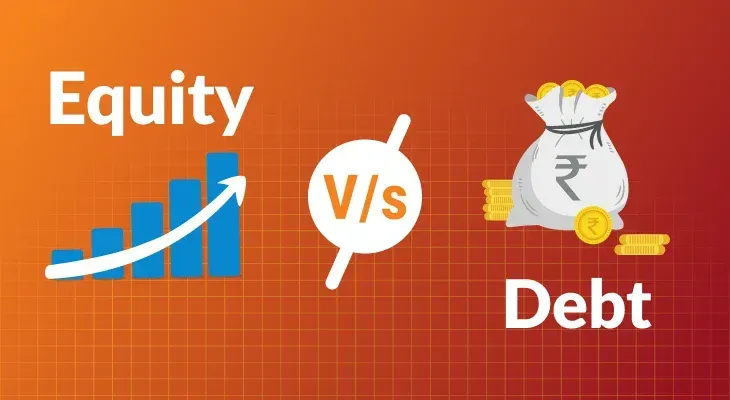
Equity vs. Debt: What's the Difference?
The diverse world of investments can be broadly divided into two major categories: Equity and Debt. While equity refers to self-owned capital of a company, debt is a company's borrowed capital. As asset classes, equity and debt are different in all aspects - structure, objectives, risk and returns etc. Hence it's important to understand the difference between equity and debt before investing your hard-earned money. In this article, we will explore the equity vs debt debate.
What is Equity?
Equity, as a direct investment asset class, allows you to buy shares of a company and, in turn, gain its ownership. Naturally, the ownership is proportional to the number of shares you own. In the case of public listed companies, these shares can be freely traded (bought or sold) using a Demat account. Furthermore, you can earn returns in the form of dividends that a company may declare based on its profits for the period. In other words, equity ownership makes you a part of the company’s actual performance. As an owner, you also bear the company’s losses.
Read Also: Everything You Need to Know About Equities
What is Debt?
Debt is the amount borrowed that needs to be paid back within stipulated period with a pre-decided interest. From an investment perspective, debt instruments come with lower risk and volatility as they are usually backed by the government or large corporate entities. Since the risk is lower and the returns more assured, the gains in debt investments are usually lower than in direct equity investments. Common debt instruments include debt mutual funds, government securities, and corporate bonds.
Read Also: What are Debt Funds: All about Debt Funds
Key differences between Equity and Debt
Particulars | Equity | Debt |
|---|---|---|
Ownership | When you buy equity shares, you become owners of a company’s common shares | When you buy debt instruments, you are giving a loan to the issuing entity. There is no exchange of ownership |
Primary source of income | Equities provide dual source of income - capital appreciation and dividend income | The primary source of income with debt instruments is interest |
Event of liquidation or bankruptcy | Being owners, equity shareholders have the last claim on a company’s assets. Debenture and preference share holders are given precedence | Debt shareholders are paid first in the event of liquidation, especially in case of secured debt |
Risk involved | Equities as an asset class are riskier than debt | Since debt shareholders are paid first and principal repayment is more or less secured, the risk involved in debt is much lower compared to equities |
Nature of Returns | Equity returns are directly dependent on the performance of the underlying company. In the event of a growth spurt, equities will generate higher returns than debt | The returns generated by debt instruments are lower than equities but they are more or less fixed. |
Management and Tracking | Direct and active tracking required along with substantial research | Can be passive in nature with less fluctuations requiring fewer follow ups |
Investment horizon | Equities are preferred asset class for long-term wealth creation | Debt investments are ideal for short to medium term investment horizon |
Which Should You Choose: Equity vs Debt?
There are many things to consider when deciding between debt and equity investments. Let’s break it down.
Risk Tolerance
Initially, you need to take risk into account. Usually, loans offer a regular return and thus are safer than stocks; however, if you want some financial risk for probable higher returns, then equities may be your choice.
Investment Goals
What do you want to achieve with your investments? Are you looking for safety for your money? Or maybe you would like to have some income on a regular basis? Bonds generate regular income while shares may provide long-term growth opportunities.
Duration Of Investment
How much time do you plan to hold the money? The bond market is appropriate for short and medium-term objectives whereas stocks usually outperform other competing options in the long run allowing them to pay better dividends over time.
Market Conditions
Observe what is happening in the economy and markets. For example, bonds often perform well when conditions are uncertain or rates are going up, but stocks usually dominate in humming economies.
Tax Implications
No one likes surprises while filing returns. Therefore, each type of investment must be understood based on how it is taxed. Interest paid on bonds is generally subject to regular income taxes while capital gains from shares might fall into different categories depending on how long they were held.
Diversification
Do not put all your eggs in one basket. In this case, it means that spreading money across various types of assets helps reduce risks associated with concentrating portfolios in a single stock. There is no hard and fast rule that you must invest in either of them. You can make a suitable combination of debt and equity and invest accordingly.
Prevailing Interest Rates
Keep an eye on interest rates because they can affect the value of bonds. When rates fall, bond prices go up; conversely, when rates rise, bond prices typically decline. Understanding these trends will assist you in making better decisions regarding investments.
Remember that it isn’t simply about the difference between debt and equity or choosing one. If you are thinking about buying company shares, then you should check out financial health and growth prospects. And if you are thinking about leaning towards debt investments, look at things such as credit ratings and the ability of the firm to make payments.
Also, keep your investment strategy under review from time to time. Since life changes and so do markets, it is better to modify your plan accordingly.
Debt-to-Equity Ratio
Out of all the ratios available to evaluate a company’s financial status, debt to equity ratio is one of the most important ones. It indicates the financial leverage of the company and its risk profile by comparing the total debt to total equity. Here’s how the debt-to-equity ratio is computed:
Debt to Equity Ratio = Total Debt / Total Equity
As an equity investor, a high debt-to-equity ratio signals you about potential risks, such as higher interest expenses or limited flexibility for growth initiatives. For debt investors, it provides insights into a company's ability to repay its debt obligations.
A high debt-to-equity ratio may indicate higher risk for debt investors too, as it suggests that the company has more debt relative to its equity, potentially impacting its ability to meet interest and principal payments.
FAQ
Which is better, debt or equity mutual fund?
The decision to invest in either debt or equity mutual funds is determined by several factors such as the investor’s financial goals and risk tolerance. These factors also form a basic difference between debt and equity mutual funds. Debt funds have lower risks since they deliver stable income from interest; conversely, equity funds generate higher returns via dividend payments and capital gains at a higher risk.
Is debt mutual fund safe?
Yes, debt mutual funds are seen as being quite secure compared to their counterparts in the equity market making them suitable for new investors. They provide predictable returns and tend not to fluctuate much due to lower volatility compared to riskier assets; therefore, they are more reliable sources of income. However, they may offer lower returns than equity funds.
Is equity good?
In case you are an aggressive investor and have more tolerance for high risk, then you can opt for equities instead of bonds as they offer higher returns. In contrast, debts, depending on how much of a return one gets, can sometimes be better than equities with low but consistent returns.


